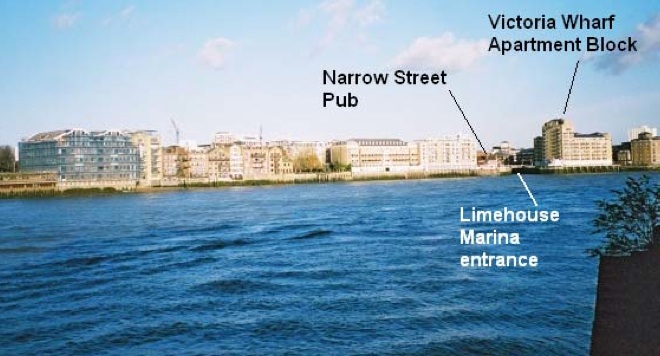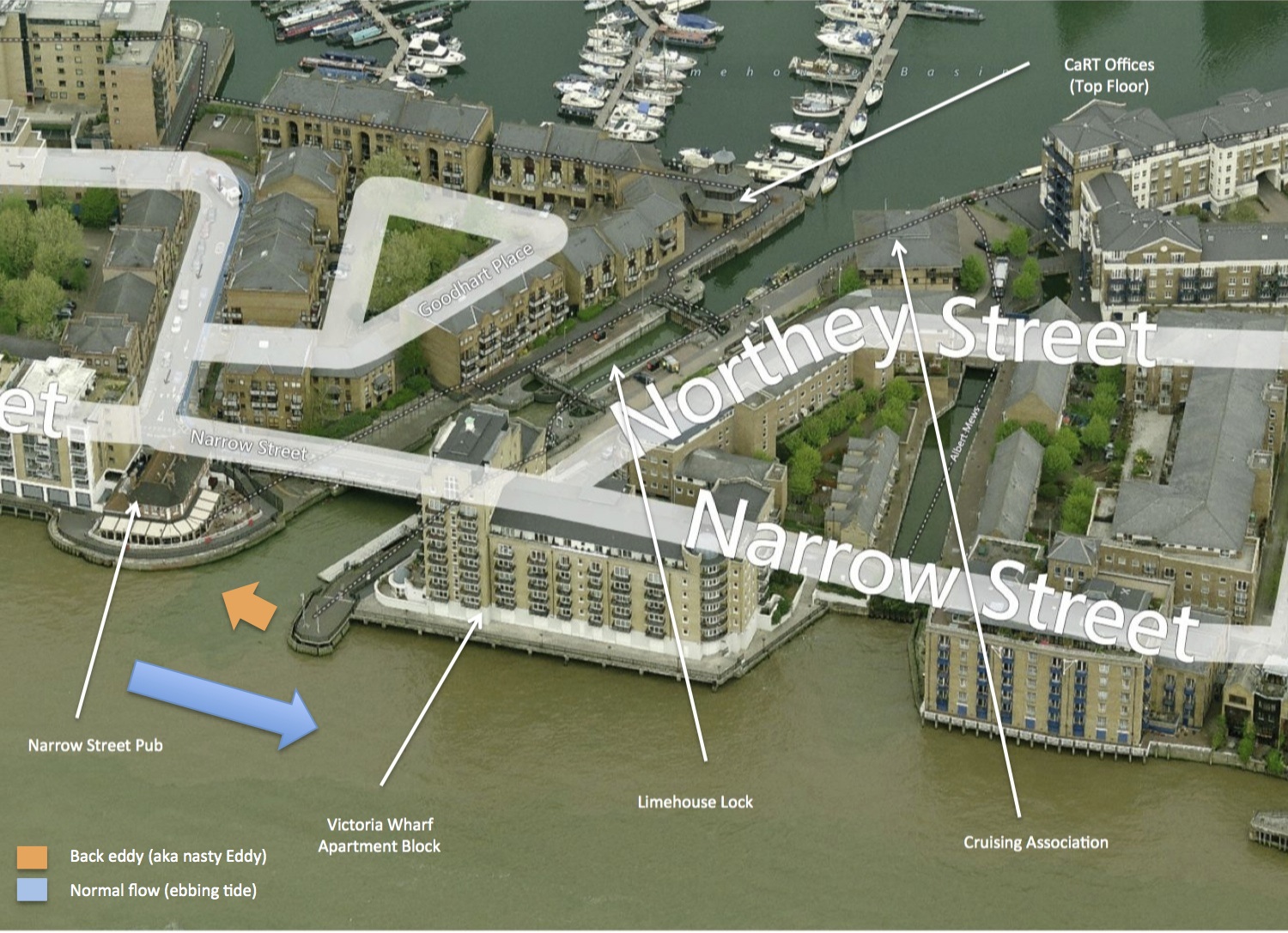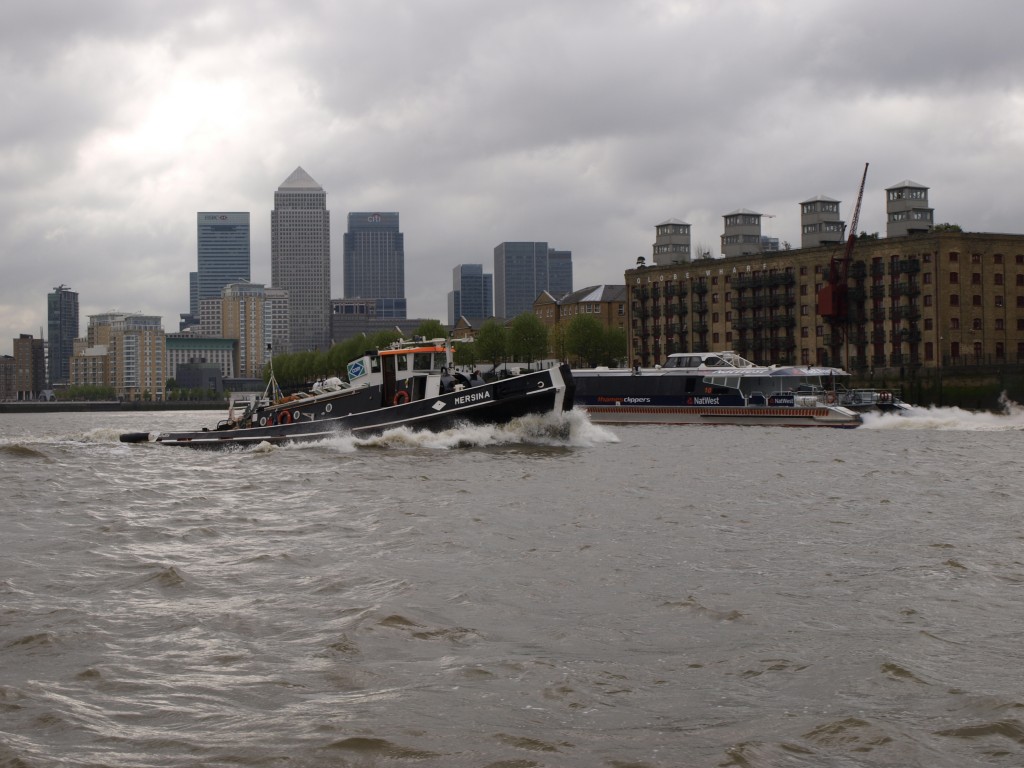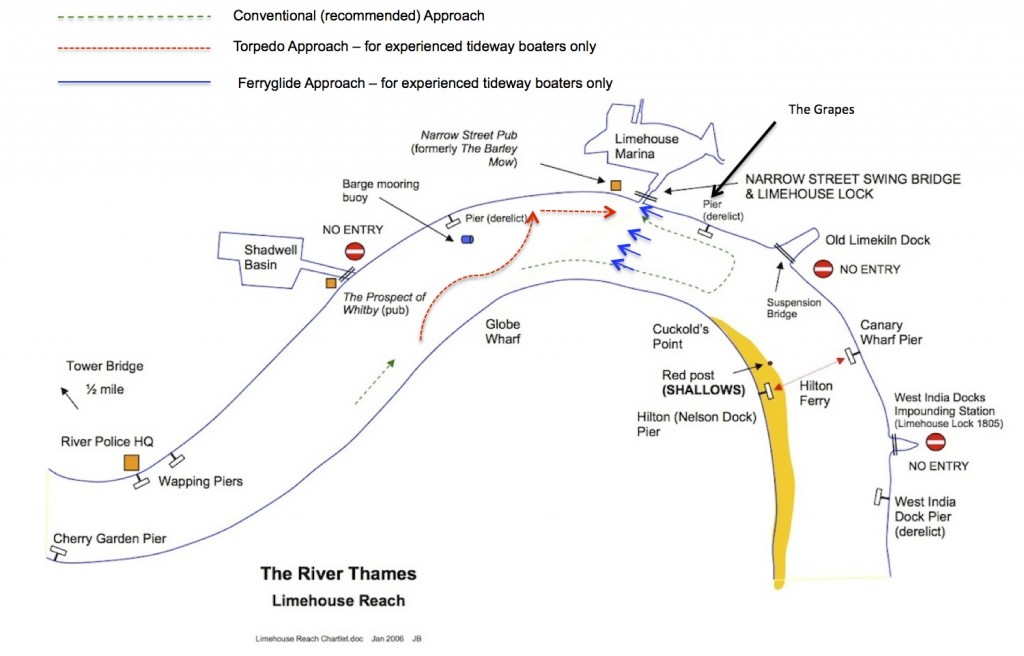Last updated: 16-08-2024 @ 09:12
Top Tips
- if possible, contact Limehouse as you go under Tower Bridge [Note: no way to do this at the moment, this subject is under discussion with CRT]
- We prefer to get into the lock by going past it, turn across the tideway and then work back upstream against the tide, these instructions are written that way but there are other techniques.
- When you see Limehouse Lock drift out from the right bank to one third of the way across the river or where you feel safe
- As you get close to Limehouse Lock get in touch with London VTS to tell them that you are a slow moving narrowboat currently heading downstream but you will turn across the tideway to get to Limehouse lock as soon as you can see it is clear.
- Stay 1 to 1½ lengths away from the north bank and gently work your way back up to the lock
- Unless you are approaching at speed don’t turn too soon
- If you find yourself being pushed sideways into the downstream wall give it more revs
- Once you have made the turn slow down
- Make sure whoever is on the front knows to take a turn of rope round the front stud to help them hold the rope
- The Grapes does a nice pint.
One part of the journey that always seems to scare narrowboaters is the turn into Limehouse. Yes it is a turn, yes nasty Eddy is lurking and worse the water does not stay still, most inconsiderate.
Actually it is not too bad at all.
As you come out from under Tower Bridge contact Limehouse to check the lock is ready for you. [Note: not currently feasible!]
Currents do funny things below Tower Bridge, there is often a little knuckle of water which generates a nice little wave and you need to concentrate to get the boat over to the right, it is a great temptation to go down the middle of the channel, don’t!
You pass Shadwell first, don’t go in there. Limehouse is very recognisable just before the turn round Canary Wharf.

Limehouse Entrance (taken from the Downstream Guide)

Limehouse Overview
- So in detail:
- The torpedo approach: Cross over before the lock, head down the last bit to the lock on the wrong side, hit the revs and make the turn, hopefully. There are a quite a few who use this technique effortlessly, Lock Keeper Jeremy has photos of those who did not quite make it.
- Ferry glide across: Make the turn as you pass the entrance and ferry glide across. Aim to get on the centreline of the lock – which points upstream – see GPS track below. It is the way that the old working boats did it before there were clippers. We have done it that way once, it worked well but has the disadvantage of not being able to see fast movers coming round the bend, something that the old working boats did not have to contend with. (Balancing the flow of the stream with the engine so the boat is virtually stopped in the water, then one can manipulate the tiller to get the boat to drift sideways). Line up the church tower with the centre of the lock.
- The recommended approach: Go past the lock, turn when you can see most of the way round the bend and the slowly work your way back upstream to the lock and make the turn very much under control.
As you come up to Limehouse drift out from the right bank, try to get yourself perhaps one third of the way across the river. On a bad day a fast moving clipper can get to you from the upstream bend in the same time that it takes you to get halfway across so give London VTS a call on channel 14 and tell that you are a slow moving narrowboat in Limehouse Reach wishing to turn across the tideway to enter Limehouse as soon as you can see it is clear. VTS may sound a bit off at times but that is simply them being brief and needing to get onto the next thing, they are your best mates and they will generally tell you if they know of anything coming to run you down. Remember you are crossing the river so you don’t have right of way.
Go past the entrance by perhaps 200m and turn as soon as you can see enough round the bend to see that no one on their right hand side is coming to get you. Turn smartly, keep the revs on to get yourself over the Limehouse marina side as quickly as you can.
Head up towards the lock staying a boat length or boat length + one half (say 80 to 90′) off the river wall and jetty remnants. You will probably need a few more revs as the river may be running at 3mph. Unless you are in a convoy take your time as it is easier to do the turn slowly. If you are in a convoy get off the river as fast as you can so the others can do the same!
When you are 2 or 3 lengths downstream of the lock consider slowing down a little bit and start gently turning when you are perhaps a length away. At this stage it is more about angling the boat over a bit, do not throttle back at this stage but be ready to give it more welly.
You have currents doing three things to you, nothing that you would not have seen on rivers beforehand:
- Nasty Eddy is a back wash that tries to send you back upstream as you go into the entrance, if you want, you can get your crew to spot the tell tale marks in the wall under the Narrow Pub. If you are reasonably central then nasty Eddy won’t get you, just watch what your front is doing and be ready to correct.
- The river tries quite hard to straighten you as you try to turn. If you are going reasonably slowly against the current then it is not too much of an issue, blip your throttle for a few seconds if you need to. If you are making a speedy entry then add a few more revs and you will find the boat heels a bit but you get in.
- If you start the turn a bit close to the wall then rather then being pushed upstream by nasty eddy, the tide tries to push you into the downstream wall. If you are sliding towards the wall hit your throttle and you sail past nicely. If you start a reasonable distance off the wall then it is not an issue.
So start gently turning a length or so away, but only gently. Unless you are in a convoy you will be coming up reasonably slowly, we have seen boats use the flow and virtually turn on the spot so do not succumb to the temptation to turn too soon but make sure that the boat is turning, particularly if you are coming in at speed. Every boat is different, everybody’s nerves are different but we increase our turn when nose is approach the downstream wall and we either hit the middle of the approach or need a few revs to stay off the downstream wall.
As soon as you have completed the turn, start throttling back, you will get up a load of speed in the bit of slack water up to the lock.
The lock keepers can follow your progress on their video camera which will pick you up between the Prospect of Whitby and Hilton Ferry. If travelling downstream from Teddington or Brentford to go into Limehouse you need to turn across the river, the turn in the river at Limehouse is blind so you ought to go a fair way round the bend before turning across the river to ensure that there is no traffic coming up towards Hilton Ferry – remember the Thames Clippers move quite quickly and the tugs towing barges can’t stop very quickly so get a good look down the river at Hilton Ferry before committing to the turn and remember the tide will usually carry you down river !
The Lock Keeper will generally stand by the vertical riser he wants you to stop at. More often then not they want you on the very front riser, basically head right to the end of the lock and stop a few millimetres off the cill. Your front crew need to take a rope through the riser and take a turn round your front stud – there are no paddles in Limehouse, they simply open the gates so you need a bit of mechanical advantage to help keep the boat in place. At the rear loop a rope through the riser and, if you can, take a turn round your stud but it is not as violent at the back so you can get away with maintaining a firm grip.The Thames Tideway guide has detailed information written by the lock keepers telling you how to use the lock. Read the guidance!
If you are single handed then talk to the Lock Keepers in advance. Leo No2 has done it single-handed.
- If you are in the company of other boats arrange for one of them to go in first and have your front warp ready and available for the person on the front of the first boat to pick up
- Make sure the lock keepers know you are single-handed (Phone call or VHF channel 80) and that you intend to come into the lock and breast up on the first boat and that the other boat is prepared for that
- Follow the first boat in giving enough time for them to become settled against the wall of the lock and secured to the risers
- One you are past the eddies outside the lock things tend to quieten down a bit so just concentrate on getting into the lock
- Bring yourself alongside the first boat making sure the front of your boat is close to the front of the first boat so the person looking after the forward warp can get hold of yours and secure it
- Bring the back of your boat alongside the back of the first boat and secure your rear warp to that boat (it helps if the boats are much the same length)
- Once secure make your way to the front of your boat (through the boat – not down the side) and secure the front rope
- Follow any instructions from the lock keepers
- If there is a third boat it is sensible for them to go against the unused wall of the lock
Lastly and most importantly you will have made the turn that all narrowboaters fear and done it well. That deserves a celebration and there is no better place to do that than at the Grapes just down the road.
____
GPS track for the ferry glide approach. This was done on the ebb tide, so the boat was pointing SIGNIFICANTLY to the left of the course shown over the ground. here( See full blog )

And here is a video of an entrance in June 2020 (full blog here). The final segment was about three feet to the left of where we should have been
And here is the transit line for the ferry glide approach (the Statue is known locally as “Christ the Steerer”).



Recent Comments